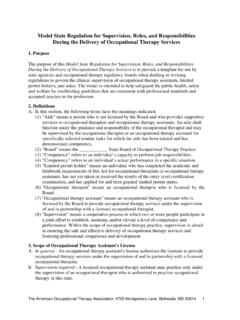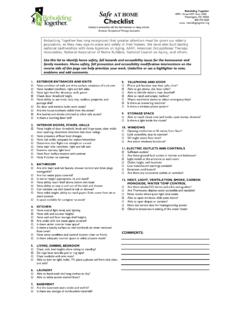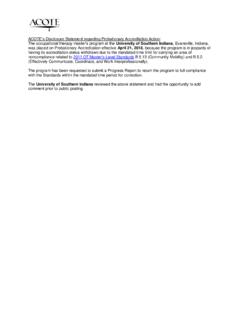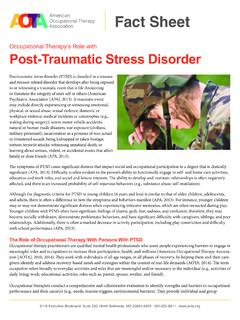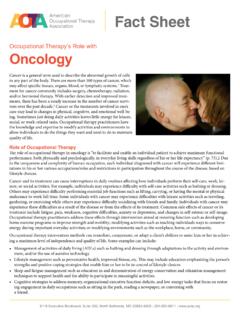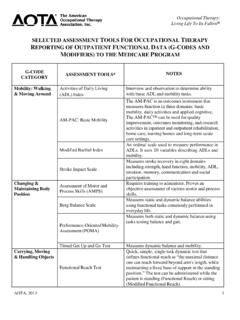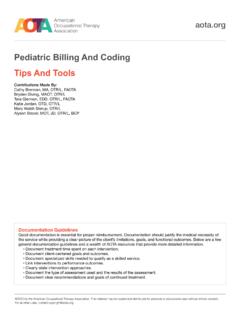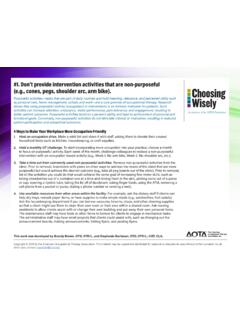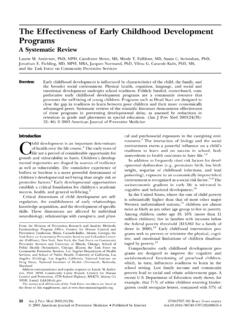Transcription of Descriptors of New CPT Occupational Therapy Evaluation Codes
1 1 Occupational Therapy Evaluations as Described in CPT Code Manual Occupational Therapy evaluations include an Occupational profile, medical and Therapy history, relevant assessments, and development of a plan of care, which reflects the therapist s clinical reasoning and interpretation of the data. Coordination, consultation, and collaboration of care with physicians, other qualified health care professionals, or agencies is provided consistent with the nature of the problem(s) and the needs of the patient, family and/or other caregivers. At a minimum, each of the following components noted in the code Descriptors must be documented, in order to report the selected level of Occupational Therapy Evaluation . Occupational Therapy evaluations include the following components: * Occupational profile and client history (medical and Therapy ); *Assessments of Occupational performance; *Clinical decision making; *Development of plan of care.
2 Report 97168 for performance of a re- Evaluation that is based on an established and ongoing plan of care. Definitions The level of the Occupational Therapy Evaluation performed is determined by patient condition, complexity of clinical decision making, and the scope and nature of the patient s performance deficits relating to physical, cognitive, or psychosocial skills to be assessed. The patient s plan of treatment should reflect assessment of each of the identified performance deficits. Performance deficits: performance deficits refer to the inability to complete activities due to the lack of skills in one or more of the categories below (ie, relating to physical, cognitive, or psychosocial skills): Physical skills: Physical skills refer to impairments of body structure or body function (eg, balance, mobility, strength, endurance, fine or gross motor coordination, sensation, dexterity).
3 Cognitive skills: Cognitive skills refer to the ability to attend, perceive, think, understand, problem solve, mentally sequence, learn, and remember resulting in the ability to organize Occupational performance in a timely and safe manner. These skills are observed when: (1) a person attends to and selects, interacts with, and uses task tools and materials; (2) carries out individual actions and steps; and (3) modifies performance when problems are encountered. psychosocial skills: psychosocial skills refer to interpersonal interactions, habits, routines and behaviors, active use of coping strategies, and/or environmental adaptations to develop skills necessary to successfully and appropriately participate in everyday tasks and social situations. 2 New CPT Code CPT Descriptors for OT Evaluation Codes 97165 Occupational Therapy Evaluation , low complexity, requiring these components: An Occupational profile and medical and Therapy history, which includes a brief history including review of medical and/or Therapy records relating to the presenting problem; An assessment(s) that identifies 1-3 performance deficits ( , relating to physical, cognitive, or psychosocial skills) that result in activity limitations and/or participation restrictions; and Clinical decision making of low complexity, which includes an analysis of the Occupational profile, analysis of data from problem-focused assessment(s), and consideration of a limited number of treatment options.
4 Patient presents with no comorbidities that affect Occupational performance. Modification of tasks or assistance ( , physical or verbal) with assessment(s) is not necessary to enable completion of Evaluation component. Typically, 30 minutes are spent face-to-face with the patient and/or family. 97166 Occupational Therapy Evaluation , moderate complexity, requiring these components: An Occupational profile and medical and Therapy history, which includes an expanded review of medical and/or Therapy records and additional review of physical, cognitive, or psychosocial history related to current functional performance; An assessment(s) that identifies 3-5 performance deficits ( , relating to physical, cognitive, or psychosocial skills) that result in activity limitations and/or participation restrictions; and Clinical decision making of moderate analytic complexity, which includes an analysis of the Occupational profile, analysis of data from detailed assessment(s), and consideration of several treatment options.
5 Patient may present with comorbidities that affect Occupational performance. Minimal to moderate modification of tasks or assistance ( , physical or verbal) with assessment(s) is necessary to enable patient to complete Evaluation component. Typically, 45 minutes are spent face-to-face with the patient and/or family. 3 CPT copyright 2016 American Medical Association. All rights reserved. CPT is a registered trademark of the American Medical Association. 97167 Occupational Therapy Evaluation , high complexity, requiring these components: An Occupational profile and medical and Therapy history, which includes review of medical and/or Therapy records and extensive additional review of physical, cognitive, or psychosocial history related to current functional performance; An assessment(s) that identify 5 or more performance deficits ( , relating to physical, cognitive, or psychosocial skills) that result in activity limitations and/or participation restrictions; and A clinical decision-making is of high analytic complexity, which includes an analysis of the patient profile, analysis of data from comprehensive assessment(s), and consideration of multiple treatment options.
6 Patient presents with comorbidities that affect Occupational performance. Significant modification of tasks or assistance ( , physical or verbal) with assessment(s) is necessary to enable patient to complete Evaluation component. Typically, 60 minutes are spent face-to-face with the patient and/or family. 97168 Reevaluation of Occupational Therapy established plan of care, requiring these components: An assessment of changes in patient functional or medical status with revised plan of care; An update to the initial Occupational profile to reflect changes in condition or environment that affect future interventions and/or goals; and A revised plan of care. A formal reevaluation is performed when there is a documented change in functional status or a significant change to the plan of care is required. Typically, 30 minutes are spent face-to-face with the patient and/or family.
7
